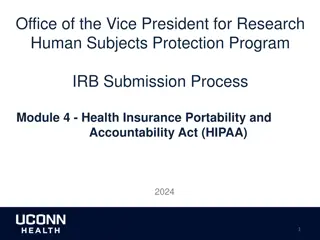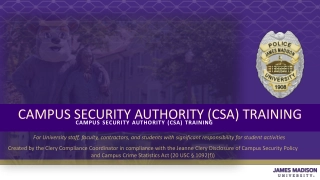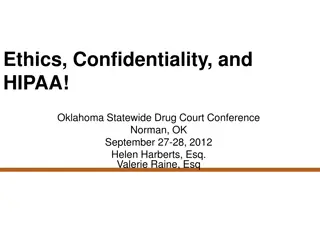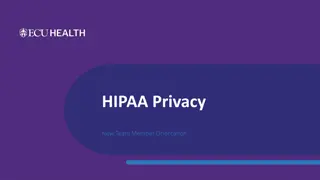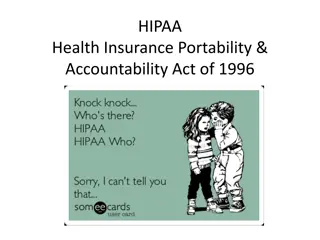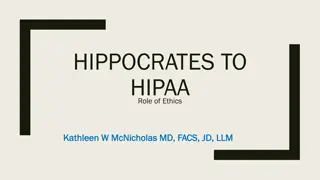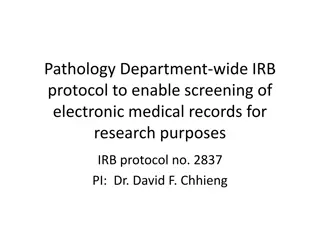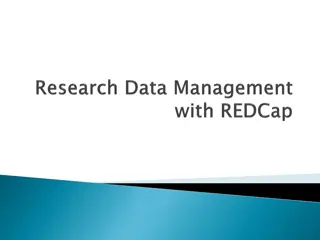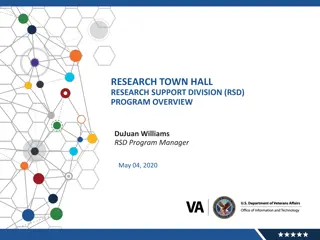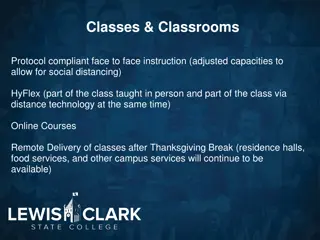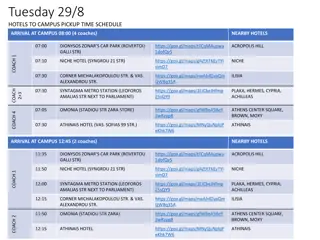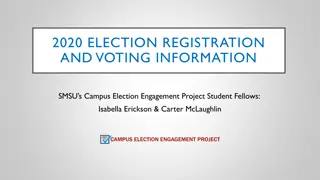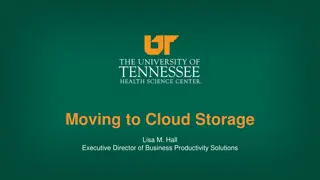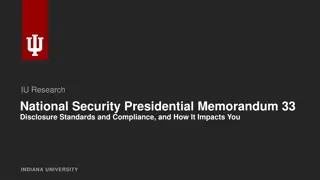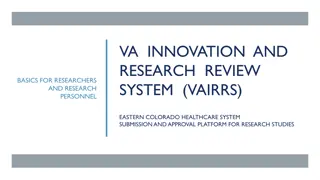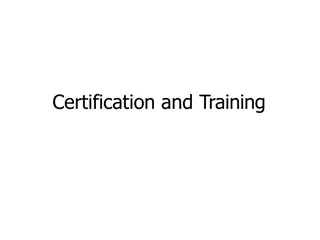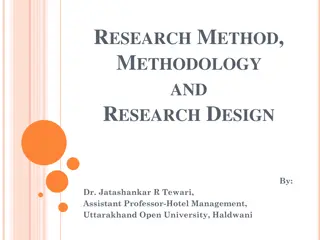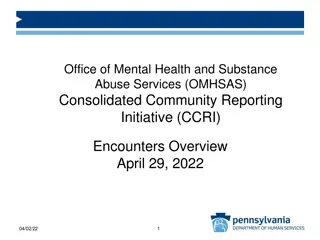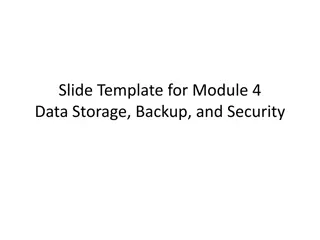HIPAA and Research Data Security Training for Researchers at BU Charles River Campus
This training provides essential information on how HIPAA impacts human subject research, the importance of protecting health data, reporting breaches, and utilizing BU resources. It also covers implications of HIPAA in research, national standards, consequences of breaches, and scenarios where HIPAA matters. Researchers are guided on when research implicates HIPAA, covered entities/components, and points where HIPAA is crucial during various research phases such as preparing proposals, recruiting subjects, and data protection. Examples, guidelines, and best practices are presented to ensure compliance and security in research activities.
Download Presentation

Please find below an Image/Link to download the presentation.
The content on the website is provided AS IS for your information and personal use only. It may not be sold, licensed, or shared on other websites without obtaining consent from the author. Download presentation by click this link. If you encounter any issues during the download, it is possible that the publisher has removed the file from their server.
E N D
Presentation Transcript
HIPAA & RESEARCH DATA SECURITY FOR BU RESEARCHERS CHARLES RIVER CAMPUS January 2018
This Training Will Cover- How HIPAA impacts human subject research What researchers need to do to protect health data used in research - whether covered by HIPAA or not How to report a possible breach of research data Your BU resources 2
HIPAA Health Insurance Portability and Accountability Act of 1996 (HIPAA). Privacy Security Breach Notification Patient Rights 3
Whats the big deal? National standards Complexity Enforcement: consequences of breach Feinstein Institute for Medical Research: data from 50 studies, 13,000 individuals; breach cost $3.9 million (unencrypted laptop) Oregon Health and Science University, $2.75 Million (unencrypted laptop) 4
When Does Research Implicate HIPAA? Human subjects research Using PHI Protected Health Information (PHI): Information about an individual s past, present, or future physical or mental health, and/or information about payment for, or provision of healthcare services, created or received by a Covered Entity/Covered Component. 5
Covered Entity/Covered Component Covered Entity: A health insurance plan, claim clearinghouse, or a healthcare provider that conducts HIPAA electronic billing (typically billing of insurance companies or Medicare/Medicaid). Covered Component: Same as a Covered Entity, but is a component of a hybrid entity that does more than healthcare. BU is a Hybrid Entity. BU Covered Components: GSDM s Dental Health Treatment Centers SAR Physical Therapy and Neuro- Rehabilitation Sargent Choice Nutrition Danielsen Institute 6
Points Where HIPAA Matters 1. Preparing proposal 2. Recruiting subjects 4. Protecting your data 3. Obtaining data 7
HIPAA in First Phase of Research: Preparations (Pre-IRB Submission) You need PHI from a BU Covered Component (or from a HIPAA Covered Entity outside BU) to prepare for research. For example: Evaluating whether the medical records contain enough potential subjects for a research study Obtaining other information from medical records to prepare the proposal or IRB submission Designing a research proposal or protocol Two options: Authorization or Waiver 8
Waiver Preparatory To Research Patient Authorization: usually impractical Waiver Preparatory to Research if: Review of PHI is necessary to prepare the protocol or engage in similar preparatory activities; The researcher will not remove or retain the PHI reviewed; and Reviewing the PHI is necessary for research purposes If you want to review data at a BU covered component, use the form available at www.bu.edu/hipaa and give it to the covered component s HIPAA Contact. Practices vary at health care providers outside BU - start by asking for the Privacy Officer Why is this necessary? Accounting 9
HIPAA in Second Phase of Research: Recruiting Subjects A treating provider can offer its own patients the opportunity to participate in research. Discussing research participation with a patient is considered part of Treatment; so no Authorization or Waiver is needed. It doesn t matter that the researcher does not personally treat each potential study subject; the clinic is considered the provider. 10
HIPAA-Compliant Recruiting Examples A physical therapist who is part of BU Physical Therapy at the Ryan Center has IRB approval to conduct a study comparing two post-knee surgery treatment regimens. Can she review patient records to get contact information for potential subjects and contact them about the research? Same research is being conducted by a researcher at Northeastern University. Can BU Physical Therapy give him that list for study recruitment purposes? 11
HIPAA in Third Phase of Research: Obtaining PHI from Covered Entity to Conduct Research There are 4 pathways to obtain PHI from a Covered Entity for an IRB-approved research study: Request only de-identified data from the Covered Entity Request a Limited Data Set, under a Data Use Agreement Get Authorization from each study subject Obtain a Waiver of Authorization from the IRB 12
First Option: Use De-Identified Data PHI that has been de-identified is no longer PHI because it does not identify any individual. But note: de-identification under HIPAA does not mean simply deleting the patient names. HIPAA regards data as de-identified only in two circumstances: If the data does not contain any of the 18 identifying elements (next slide), or If the data contains some of those 18 identifying elements, but an expert has determined there is a very small risk of using the data to identify individuals. If you wish to pursue an expert determination, contact the BU Privacy Officer at hipaa@bu.edu so she can assist in ensuring the expert uses methods advised by HIPAA. 13
18 Identifiers That Must Be Absent To De-identify PHI Social Security numbers Medical record numbers Health plan beneficiary numbers Account numbers Certificate/license numbers Vehicle identifiers, e.g., serial numbers, license plate numbers Device identifiers and serial numbers Web Universal Resource Locators (URLs) Internet Protocol (IP) address Biometric identifiers, including finger and voice prints Full face photographic images and any comparable images Any other unique identifying number, characteristic, or code Names All geographic subdivisions smaller than a State All elements of dates (except year) for dates directly related to an individual: birth date admission date discharge date date of death all ages over 89 Telephone numbers Fax numbers Electronic mail addresses 14
Second Option: Use a Limited Data Set Do not have to remove all 18 identifying elements. Can leave the following: town or city and zip code of subject dates related to the subject, e.g., dates of birth, death, admission, testing, etc. Must enter into a Data Use Agreement with the Covered Entity that specifies how you will protect and use the data If you wish to pursue this method, contact the BU Privacy Officer at hipaa@bu.edu 15
Third Option: Obtain Patient Authorization Researchers can obtain PHI from a Covered Entity or BU covered component if subjects sign a HIPAA authorization The HIPAA Authorization may be combined with the study Consent, or it may be separate Practice tip - Identify all covered entities whose records you will be seeking and name each in the Authorization 16
Fourth Option: IRB Waiver of Authorization Conditions for granting a Waiver: PHI is necessary for the research, The research cannot be conducted without a waiver (usually because obtaining individual Authorization is impractical) and The research does not involve more than a minimal risk to individuals based on the following: An adequate plan to protect the identifiers from improper use An adequate plan to destroy identifiers at the earliest opportunity Assurance that the PHI will not be used for any purpose other than that study, and it won t be further disclosed 17
4. Protecting Your Research Data 18
Major Risks: Lost or Stolen: Laptop Portable device (e.g., flash drive) Paper or other tangible research data Cyberattack Malware Phishing attack Exploit operating system, application vulnerabilities 19
HIPAA Is Not The Only Law Out There Many laws may protect your human subjects research data, for example: Massachusetts Standards for Protection of Personal Information (93H / 201 CMR 17) Payment Card Industry Data Security Standard Export Control Law Controlled Unclassified Information (32 CFR Part 2002) Human Subjects and other research regulations, and HIPAA 20
BUs Data Categories Make it Simple[r] Restricted Use: loss/misuse may require notification to individuals or government agency HIPAA PHI and other personally identifiable health data used in research Code or key to re-identify data Confidential: loss or misuse may adversely affect individuals or BU business Human subjects research with non-health data (e.g., College of Arts and Sciences investigating whether pre-teen music lessons impact academic success) De-identified PHI/health data Internal: potentially sensitive Public: does not require protection from disclosure 21
But my research data is always deidentified. Are you sure? That means your data has no dates and no geographic signifiers, or any of the 18 elements listed in HIPAA And, that no one can identify an individual from your data either alone or in combination with other available data. Cautionary tale: Iowa insurance executive: Health costs are skyrocketing! It costs $1 million per month to cover treatment for one 17 year old boy s with hemophilia. 22
Minimum Security Standards for Non-Public Data The BU Data Protection Standards identify Minimum Security Standards for all non- public data (Restricted Use, Confidential, and Internal) http://www.bu.edu/policies/information-security-home/data-protection-standards/minimum- security-standards/ 4 Easy Rules 1. Device standards 2. Data storage options 3. Data sharing options 4. Foil Hackers 1 Big Theme ENCRYPT! 23
1. Device Standards for Non-Public Data Devices = desktops, laptops, and phones Devices must have: Operating systems and applications that are supported and updated Anti-Malware installed and set to auto update and scan Auto screen lock (15 min max) to password/code Disk encryption (best practice but required for Restricted Use data) Note: Your personal devices do not need to meet these standards unless you use them to access, process, or store research data. 24
How Do I Make Sure my Device is OK? BU has guidance here: http://www.bu.edu/tech/support/information-security/securing-your-devices/ Then get free help: IS&T Help Center: http://www.bu.edu/tech/about/help-center/ 25
Once Device is OK, Keep it That Way Keep operating systems and applications up to date, by enabling auto-update or promptly updating when notified Periodically change your strong password, following best practices: http://www.bu.edu/tech/about/security-resources/bestpractice/passwords/ Regularly delete files when no longer needed, including emails and downloads 26
2. Data Storage Options BU network storage Cloud: BU Microsoft One Drive BU s Dropbox Encrypted Removable media (e.g., CD, DVD, USB key/stick) BU Google Drive-- for Confidential or Internal data only (not Restricted Use) Check the BU IT site from time to time; IT is always looking for new secure options, and will add them here: http://www.bu.edu/tech/support/storage-options/ 27
3. Data Sharing Cloud sharing same as cloud storage: BU Dropbox BU Microsoft One Drive (Restricted Use) or BU Google Drive (Confidential) Email: Encrypt! 1. Use Data Motion to send a secure encrypted email or 2. Encrypt the document or spreadsheet before attaching it. Tip: Provide the password to the recipient by telephone - Do not send the password by email because it can be intercepted as well. 28
4. Foil Hackers and Fight Phishing! Most people think it would never happen to them, but it regularly happens to BU faculty, staff, and students Typical signs: Email asks for password BU will never ask for login credentials through email Appears to be from someone you know but has an unexpected attachment Contains unexpected grammatical or spelling errors If there is any doubt, please forward the email to abuse@bu.edu and get advice Learn more at BU s How to Fight Phishing webpage: http://www.bu.edu/tech/services/cccs/email/unwanted-email/how-to-fight-phishing/ 29
Check Before You Click Only enter login credentials if website address has green component (EV Cert) and starts with https:// Without the s preceding the colon, the website is not safe 30
Additional Tips: Safeguards for Working Remotely Use the BU VPN (vpn.bu.edu) Do not leave devices unattended (e.g., coffee shops, cars) Lock up devices when not in use (e.g., cable lock, locked room) 31
Additional Tips: Protect Documents and Tangible Data Do not remove documents or tangible data from the office. If you do, don t leave unattended (e.g., car, classroom, coffee shop) Lock up when not in use Shred when no longer necessary never throw in trash. 32
BREACHES: What are they? How do I report? 33
Reporting Potential Breach/Loss of Data: Why Is It So Important? BU may have an obligation to report the incident to individuals, the IRB, or state and federal authorities BU may be able to prevent or minimize damage Please note that any external reporting to governmental agencies or individuals whose data has been breached is handled by your BU HIPAA Privacy and Security Officers, Information Security, irt@bu.edu OGC, and other BU offices. Your responsibility is to report any suspected security incidents to irt@bu.edu, and assist as requested in any investigation. 34
What Events Must Be Reported? Unusual system activity, including: Malware detections Unexpected logins System or application alerts indicating a problem Unusual behavior such as seeming loss of control of mouse or keyboard Unauthorized access, use, disclosure, or loss, including: Loss of a device (personal or BU-owned) used to access research data Loss of tangible (paper or other) research data Emailing without encryption 35
How to Report Security Concerns, Security Incidents, and Potential Breaches: Send an email to BU s Incident Response Team (IRT): irt@bu.edu. IRT will triage the report and contact the appropriate persons and offices If you forget the irt@bu.edu email address, report to the principal investigator, the IRB, or hipaa@bu.edu BU prohibits retaliation for reporting security concerns, security incidents, and potential breaches 36
Additional Resources This PowerPoint will be available at www.bu.edu/hipaa BU Data Protection Standards: http://www.bu.edu/policies/information-security- home/data-protection-standards/ BU HIPAA policies, forms and resources: http://www.bu.edu/hipaa BU HIPAA Security Officer David Corbett: corbettd@bu.edu BU HIPAA Privacy Officer Diane Lindquist: dlindq@bu.edu Both receive emails at this address: hipaa@bu.edu NIH education materials https://privacyruleandresearch.nih.gov/clin_research.asp 37


